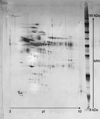Nanoparticle interaction with plasma proteins as it relates to particle biodistribution, biocompatibility and therapeutic efficacy
- PMID: 19376175
- PMCID: PMC3683962
- DOI: 10.1016/j.addr.2009.03.009
Nanoparticle interaction with plasma proteins as it relates to particle biodistribution, biocompatibility and therapeutic efficacy
Abstract
Proteins bind the surfaces of nanoparticles, and biological materials in general, immediately upon introduction of the materials into a physiological environment. The further biological response of the body is influenced by the nanoparticle-protein complex. The nanoparticle's composition and surface chemistry dictate the extent and specificity of protein binding. Protein binding is one of the key elements that affects biodistribution of the nanoparticles throughout the body. Here we review recent research on nanoparticle physicochemical properties important for protein binding, techniques for isolation and identification of nanoparticle-bound proteins, and how these proteins can influence particle biodistribution and biocompatibility. Understanding the nanoparticle-protein complex is necessary for control and manipulation of protein binding, and allows for improved engineering of nanoparticles with favorable bioavailability and biodistribution.
Figures


References
-
- National Nanotechnology Initiative. The Initiative and Its Implementation Plan. 2000
-
- Sahoo B, Goswami M, Nag S, Maiti S. Spontaneous formation of a protein corona prevents the loss of quantum dot fluorescence in physiological buffers. Chem. Phys. Lett. 2007;445:217–220.
-
- Lynch I, Dawson KA. Protein-nanoparticle interactions. Nano Today. 2008;3:40–47.
-
- Cedervall T, Lynch I, Foy M, Berggard T, Donnelly SC, Cagney G, Linse S, Dawson KA. Detailed identification of plasma proteins adsorbed on copolymer nanoparticles. Angew. Chem., Int Ed. Engl. 2007;46:5754–5756. - PubMed
Publication types
MeSH terms
Substances
Grants and funding
LinkOut - more resources
Full Text Sources
Other Literature Sources

